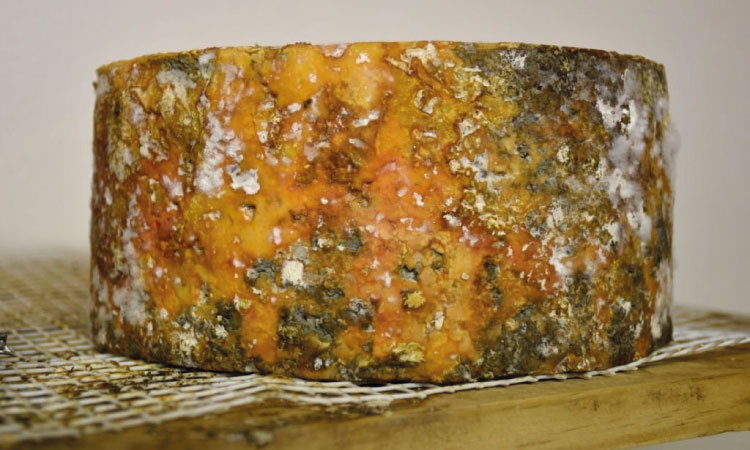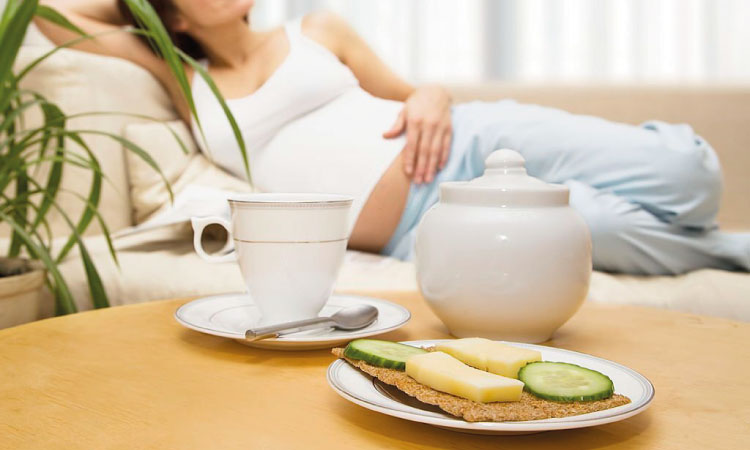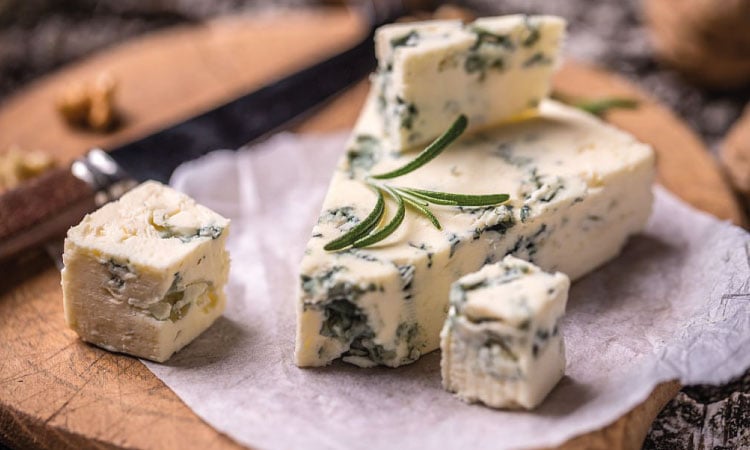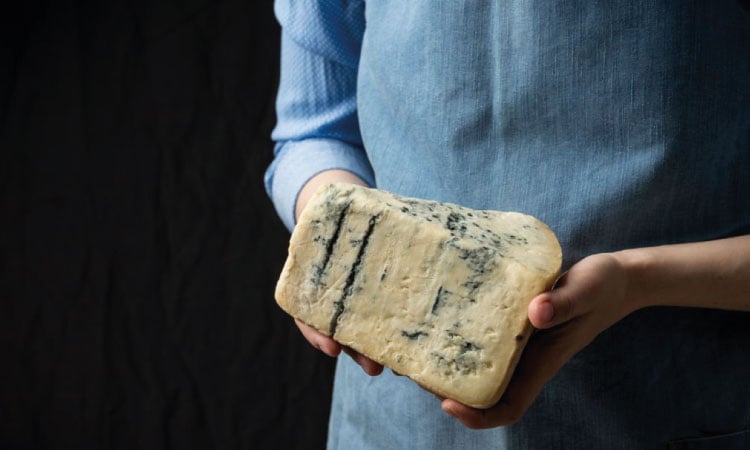It’s common to experience cravings during pregnancy, and cheese cravings are no exception. Cheese is an excellent source of calcium and can be included in a healthy, balanced diet. However, you should be aware that some cheeses can contain a lot of fat. Cheese comes in a wide variety of flavors, and many of them can be safely consumed by pregnant women. On the other hand, some cheeses should not be consumed due to the increased risk of harmful bacteria such as listeria developing in them. What about blue cheese? How safe is blue cheese during pregnancy?
What Is Blue Cheese?
Blue cheese is a type of aged cheese that can be made from the milk of cows, goats, or sheep. Cheese that has been allowed to ripen for a longer period of time, anywhere from a few weeks to several years, is referred to as aged cheese. The texture of aged cheese will be more firm than that of young cheese.
Blue cheese is a mold-ripened cheese. Penicillium is the mold used to produce blue cheese. Penicillium gives the cheese its distinctive flavor, aroma, and appearance. Although some strains of Penicillium, such as Penicillium expansum, can be harmful if consumed, the strains used to make blue cheese, Penicillium roqueforti and Penicillium glaucum, do not produce mycotoxins and are therefore considered safe for consumption during pregnancy.
Blue cheese has a salty, pungent, and sharp flavor. It is also called bleu cheese. The distinctive feature of this cheese is a pattern of bluish spots. It goes well with fruits and nuts and can be used to make sauces or salad dressings. When it comes to dipping vegetables, blue cheese is a go-to choice.
Nutritional Value Of Blue Cheese
According to the source, 100 grams of blue cheese has 353 calories and around 42 grams of water. Also,
- 21.4 grams of protein. In blue cheese, the primary source of protein is casein, a type of milk protein that contains all nine of the essential amino acids1. As blue cheese is a dairy product, the proteins found in cheese are from milk proteins (whey and casein). However, during the cheese-making process, whey is removed while casein remains in the cheese
- Blue cheese is an excellent source of the essential vitamins and minerals calcium (528mg), phosphorous (387 mg), potassium (256 mg), sodium (1150 mg), and vitamin A (196 µg)
- It also contains choline, folate, vitamin D
- Blue cheese also contains traces of Vitamin K, iron, selenium, manganese copper, and zinc
- No fiber is present in blue cheese
Note: Low-fat and low-sodium versions of blue cheese are also available. Blue cheese’s nutritional value will vary depending on the type of milk used and whether or not the fat has been removed.
Related Reading: Top 10 Calcium Rich Foods For Pregnancy
What Is The Process Of Making Blue Cheese?

A variety of factors influence the final flavor and texture of blue cheese, including milk type, animal diet, and cheesemaking technique.
Calculate Due Date With LMP
Generally, the following steps are involved in the production of blue cheese:
- Step 1: Pasteurize raw milk. The pasteurized raw milk is now combined with a starter culture to convert lactose into lactic acid, thereby solidifying the liquid milk
- Step 2: Rennet is added to help coagulate the milk. Rennet is a complex group of digestive enzymes produced by ruminant mammals. It is most prevalent in the lining of the fourth stomach of goats, calves, and lambs when milk is their primary source of nutrition
- Step 3: The curds are cut to let the whey out. After the whey has been drained out, the curds are shaped into wheels or blocks
- Step 4: During this stage, mold is added. The cheese is sprinkled with Penicillium roqueforti and salted to prevent spoilage
- Step 5: Stainless steel rods are poked into the cheese to stimulate oxygen circulation, which allows the mold to grow and gives the cheese its blue or green veins. This is also referred to as “needling.” Salt is also added to prevent spoilage. Softening the texture and developing the cheese’s distinctive blue color are the results of this process
- Step 6: Age the cheese. It takes 60 to 90 days for the cheese to age
In addition to the basic steps outlined above, different types of milk, temperatures, salt contents, aging times, and other variables are used to create different kinds of blue cheese.
Types Of Blue Cheese
There are dozens of blue cheese varieties. It is possible to find most varieties of cheese in the Indian market despite the fact that the three most popular kinds of cheese, French Roquefort, English stilton, and Italian gorgonzola, originate outside of the country.
Listed below are a few of the more well-known types of cheese:
- Roquefort: Roquefort is believed to be one of the oldest blue cheeses. It is produced from sheep’s milk. In times past, this cheese was aged on the limestone cliffs that can be found in the southern region of France. The flavor and aroma of this blue cheese are unparalleled to those of any other variety
- Cambozola: This blue cheese is also known as a “double-cream blue cheese”. This is due to the fact that it is made from both cow’s milk and cream
- Gorgonzola: It is a cow’s milk-based Italian cheese. Gorgonzola is soft, buttery, and creamy with tiny hints of sharp blue
- Danablu: It is a blue cheese made from Danish cow’s milk. In comparison to other blue cheeses, it has a milder flavor and a creamier, smoother texture
- Blue Stilton: Blue Stilton is a cheese made from cow’s milk and is traditionally produced in the English Midlands. It has strong consistency and is shaped like a cylinder. Blue veins are beautifully carved into their marbled surface. An earthy, creamy, nutty, and salty flavor is accompanied by a slightly moist, crumbly texture. It isn’t aged with mold
- Cabrales: This cheese is made from cow’s milk in Asturias, Spain. Cabrales has a wild and spicy flavor and aroma, with distinct salty notes that intensify with their age
Related Reading: Tofu During Pregnancy- Benefits And Health Risks
Can Pregnant Women Eat Blue Cheese?
When pregnant, you should make sure the type of blue cheese you’re eating is safe to consume. Not all varieties are safe. Is cooked blue cheese pregnancy safe?
Expecting women can enjoy both soft, mold-ripened and soft, blue-veined cheeses if they cook them thoroughly. Listeria is destroyed by exposure to high temperatures2. Ensure that you have cooked the cheese until it is thoroughly hot, not just melted.
So, is a blue cheese that has been pasteurized completely safe to eat while pregnant? Contrary to many other foods, blue cheese’s pregnancy safety isn’t solely dependent on whether it has been pasteurized. Whether it’s soft (which contains more water) or hard cheese also determines the safety of blue cheese during pregnancy. Hard blue cheeses, such as stilton, are not likely to contain listeria, even when made with unpasteurized milk.
Unsafe Blue Cheese During Pregnancy
It is important to know which kinds of blue cheese are unsafe while pregnant. Pregnant women should avoid eating soft blue cheeses because they may contain higher levels of Listeria bacteria, which can cause serious pregnancy complications.
Examples of soft blue cheeses that are unsafe are:
- Danish blue
- Gorgonzola cheese
- Blue brie
- Roquefort cheese
- Cambozola cheese
Related Reading: Causes, Signs And Remedies For Food Poisoning During Pregnancy
Risks Of Eating Blue Cheese During Pregnancy

It is not because blue cheese is made with mold that it is dangerous to eat while pregnant. Molds used in the production of blue cheese are safe for human consumption. It is important to keep in mind that the spotted appearance of blue cheese is merely a sign that fermentation is taking place, not a sign that the cheese contains toxins that were produced by mold.
1. The risk of contracting listeriosis
The consumption of blue cheese during pregnancy is associated with an increased risk of miscarriage because the cheese is made with unpasteurized milk rather than the mold that is traditionally used. Any dairy product that is made with unpasteurized milk increases the risk of contamination with Listeria monocytogenes. This increases the risk of contracting listeriosis.
Note: Take into consideration the fact that heat can inactivate Listeria. So, it’s likely safe to eat well-cooked dishes with blue cheese while pregnant. Listeria was much less active when the temperature was 131°F (55°C)3.
2. Cause weight gain
Due to its high-calorie density, blue cheese can cause weight gain. Therefore, women who are pregnant and have a problem with being overweight should avoid eating blue cheese to further avoid pregnancy complications because of excessive weight. Additionally, blue cheese contains approximately 29 grams of saturated fat for every 100 grams of cheese, which may cause an increase in blood cholesterol levels4.
3. Can contribute to pregnancy hypertension
A diet that is high in sodium can make it more challenging to maintain healthy blood pressure levels. The sodium content of blue cheese is relatively high. Therefore, pregnant women who are prone to hypertension or who are supposed to adhere to a diet low in sodium should refrain from eating blue cheese.
Related Reading: 9 Early Warning Signs Of Postpartum Depression To Watch Out For
What To Do If You Ate Blue Cheese During Pregnancy?
Don’t be alarmed if you’re pregnant and have consumed blue cheese. A single incident of accidental consumption of raw blue cheese is probably not going to cause any problems for you or your unborn child. In any case, safety always comes first. Since listeria infections (listeriosis) can develop up to 30 days after ingestion, watch out for the following symptoms5:
- Diarrhea
- Vomiting
- Fever
- Nausea
Listeriosis can range from mild to life-threatening. Do not hesitate to seek medical attention if you experience any of the above symptoms. Listeriosis can be diagnosed using a blood test. When listeriosis is detected early enough, antibiotics are often prescribed as an effective treatment.
How To Make The Right Choice?
Since there are so many varieties of blue cheese, one can frequently be swapped out for a more secure option. Bleu cheeses that have been pasteurized, such as Stilton or Danish Blue, are a safe bet. The risk of listeriosis will be eliminated by the pasteurization procedure.
Similarly, if mold grows in any part of a package of sliced or crumbled blue cheese, then the entire package needs to be thrown away. Blue cheese and other milk-based products should be avoided by those with dairy allergies as well.
Conclusion

That’s about all you need to know about blue cheese. In general, soft cheeses should only be consumed when they are piping hot. It is safe to consume hard cheeses since they rarely cause health problems. Make sure the soft cheeses you buy are made with pasteurized milk if you find yourself reaching for them on a regular basis. Pasteurization eliminates all microorganisms, making the food completely safe during pregnancy.
FAQs
Wondering is crumbled blue cheese pregnancy safe? If prepared with pasteurized milk, blue cheese crumbles are safe to consume. Similarly, blue cheese crumbles made from hard cheese are totally safe.
Besides blue cheese, blue cheese dressings typically consist of sour cream, mayonnaise, onion powder, buttermilk, milk, vinegar, and garlic powder.
Even if the blue cheese used in the dressing has been pasteurized, the other ingredients in the dressing may not have been pasteurized. Pregnant women may want to steer clear of that kind of blue cheese dressing just to be safe.
However, pasteurized blue cheese dressing is safe to eat.
Stilton, a blue cheese variety, is considered safe for consumption by expectant women. Stilton is a hard blue cheese. Because of the low moisture content and higher acidity, Listeria cannot survive there.
So even though Stilton is made from unpasteurized milk, pregnant women can still enjoy it without fear of harm. Aside from Stilton, no other soft or hard cheese made with raw milk should be consumed by pregnant women.


